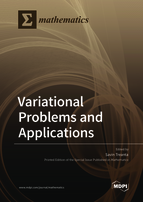Variational Problems and Applications
A special issue of Mathematics (ISSN 2227-7390). This special issue belongs to the section "Dynamical Systems".
Deadline for manuscript submissions: closed (31 July 2022) | Viewed by 22899
Special Issue Editor
Interests: variational and functional analysis; optimization methods; control theory; differential equations
Special Issues, Collections and Topics in MDPI journals
Special Issue Information
Dear Colleagues,
Over time, many researchers have been interested in obtaining solution procedures in variational (interval/fuzzy) analysis and robust control. In order to formulate necessary and sufficient optimality/efficiency conditions and duality theorems for different classes of robust and interval-valued/fuzzy variational problems, various approaches have been proposed. The current Special Issue is situated around studies of uncertain variational problems. This Special Issue aims to develop the research in this field by formulating and demonstrating some characterization results of well-posedness and robust efficient solutions in new classes of (multiobjective) variational (control) problems governed by multiple and/or path-independent curvilinear integral cost functionals and robust mixed and/or isoperimetric constraints involving first- and second-order partial differential equations. Therefore, I cordially invite you to publish your results on related subjects (variational inequalities, evolutionary problems, and so on) in this Special Issue.
Prof. Dr. Savin Treanta
Guest Editor
Manuscript Submission Information
Manuscripts should be submitted online at www.mdpi.com by registering and logging in to this website. Once you are registered, click here to go to the submission form. Manuscripts can be submitted until the deadline. All submissions that pass pre-check are peer-reviewed. Accepted papers will be published continuously in the journal (as soon as accepted) and will be listed together on the special issue website. Research articles, review articles as well as short communications are invited. For planned papers, a title and short abstract (about 100 words) can be sent to the Editorial Office for announcement on this website.
Submitted manuscripts should not have been published previously, nor be under consideration for publication elsewhere (except conference proceedings papers). All manuscripts are thoroughly refereed through a single-blind peer-review process. A guide for authors and other relevant information for submission of manuscripts is available on the Instructions for Authors page. Mathematics is an international peer-reviewed open access semimonthly journal published by MDPI.
Please visit the Instructions for Authors page before submitting a manuscript. The Article Processing Charge (APC) for publication in this open access journal is 2600 CHF (Swiss Francs). Submitted papers should be well formatted and use good English. Authors may use MDPI's English editing service prior to publication or during author revisions.
Keywords
- optimization problems
- optimal control
- variational problems
- well-posedness
- partial differential equations
- generalized convexity
- dynamical systems






